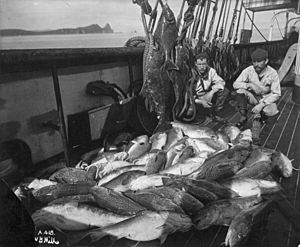District of Alaska facts for kids
Quick facts for kids District of Alaska |
|||||||||
|---|---|---|---|---|---|---|---|---|---|
| Unorganized territory of the United States | |||||||||
| 1884–1912 | |||||||||
| History | |||||||||
|
• District of Alaska
|
17 May 1884 | ||||||||
| 24 August 1912 | |||||||||
|
|||||||||
 |
| History of Alaska |
|---|
| Prehistory |
| Russian America (1733–1867) |
| Department of Alaska (1867–1884) |
| District of Alaska (1884–1912) |
| Territory of Alaska (1912–1959) |
| State of Alaska (1959–present) |
| Other topics |
The District of Alaska was how the United States government officially called Alaska between May 17, 1884, and August 24, 1912. After this period, it became the Territory of Alaska. Before 1884, from 1867, Alaska was known as the Department of Alaska. During that time, it was mostly managed by the military.
Being called a "district" meant Alaska was a part of the U.S. but did not yet have its own organized local government. It was an "unorganized territory." The governor of the District of Alaska was chosen by the president of the United States.
Contents
Becoming a District: Why Alaska Changed
When the United States bought Alaska in 1867, lawmakers in Washington, D.C., were busy with problems after the American Civil War. They did not have much time to focus on Alaska. So, Alaska was first managed as a military area. The United States Army was in charge until 1877. Then, the United States Department of the Treasury took over until 1879. Finally, the United States Navy managed Alaska until 1884.
By 1884, more people had moved to Alaska. President Chester A. Arthur then signed a law called the First Organic Act. This law created a civil government for Alaska, changing it from a military department to a district.
Life in the District of Alaska
| Historical population | ||
|---|---|---|
| Year | Pop. | ±% |
| 1890 | 32,052 | — |
| 1900 | 63,592 | +98.4% |
| 1910 | 64,356 | +1.2% |
| Source: 1890–1910; | ||
A big change happened when gold was found in the Yukon in 1896. The Yukon is in Canada, but many people thought it was in Alaska. Still, the easiest way to get there was by ship to Alaskan towns like Skagway or Dyea. From there, miners could choose two mountain paths to the gold fields.
- The Chilkoot Trail started in Dyea. It was shorter but very steep.
- The White Pass started in Skagway. It was longer but not as steep.
Skagway and the White Pass trail had a lot of crime. A famous bad guy named Soapy Smith caused trouble there. He was eventually killed in Skagway.
Gold Discoveries in Alaska
Many people who did not find gold in the Yukon came back to Alaska to search. Gold had already been found near Juneau in Southeast Alaska. More gold was discovered in Nome in 1899.
In 1902, a prospector named Felix Pedro finally found gold in the Tanana Hills. This discovery led to a new town forming quickly. This town was named Fairbanks, after U.S. Senator Charles W. Fairbanks. Fairbanks grew fast as more miners and businesses arrived. It became a busy center with shops and cafes. People could travel there by river or by an overland route to Valdez.
The Tanana Mining District became a huge gold producer. In 1903, work began on what would become the Alaska Railroad. This railroad would connect Seward to Fairbanks by 1923. However, Alaska still does not have a railroad connecting it to the rest of the United States.
New Ways to Make Money
Many Alaskans found ways to earn money from the gold rushes without digging for gold themselves. For example, when gold was found at Ruby Creek in 1907 and 1910, many miners came. The steamboats they used needed a lot of wood. So, people living along the river made money by selling wood. The town of Ruby grew from a tent city to a busy river port.
Other valuable metals were also mined in Alaska, especially copper. In 1910, the richest copper mine in the world opened at Kennicott. This mine produced a lot of copper and employed many workers.
Traditional Lifestyles and New Industries
Traditional ways of life, like fishing, also provided jobs for many Alaskans. This became even more important after canning was introduced. In 1878, the first two canneries were built in Klawock and Sitka. These factories helped process and preserve fish. By the early 1900s, commercial fishing was growing in the Aleutian Islands. Factories salted cod and herring, and more salmon canneries opened.
Whaling was another traditional job. However, people hunted bowhead whales so much for their oil that the whales almost disappeared. Luckily, their numbers have grown back in recent years. The Aleuts, who are Native people of Alaska, faced problems because there were fewer fur seals and sea otters. They needed these animals for food and for the skins to cover their boats. Americans also moved into other parts of Alaska, using the animals and fish that Native people depended on.
See also
 In Spanish: Distrito de Alaska para niños
In Spanish: Distrito de Alaska para niños





